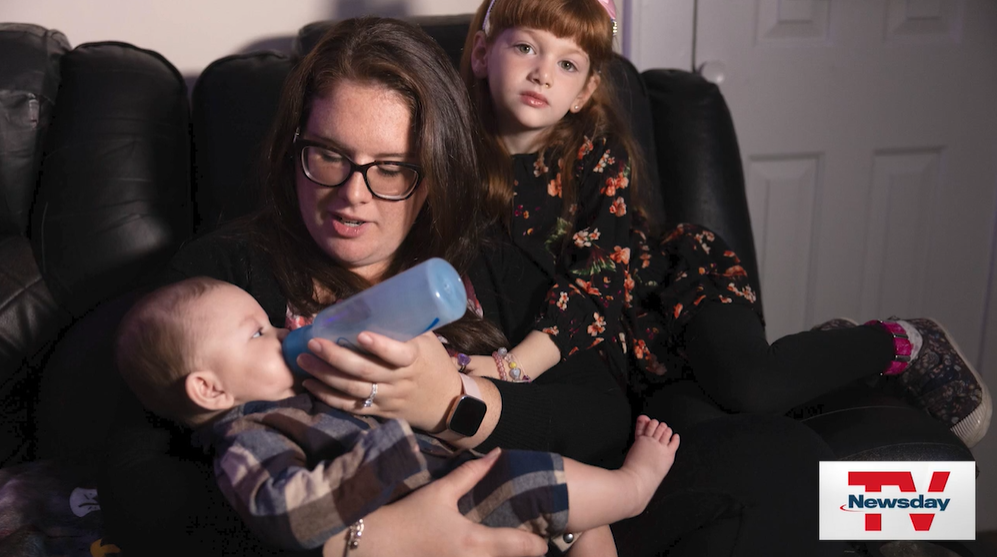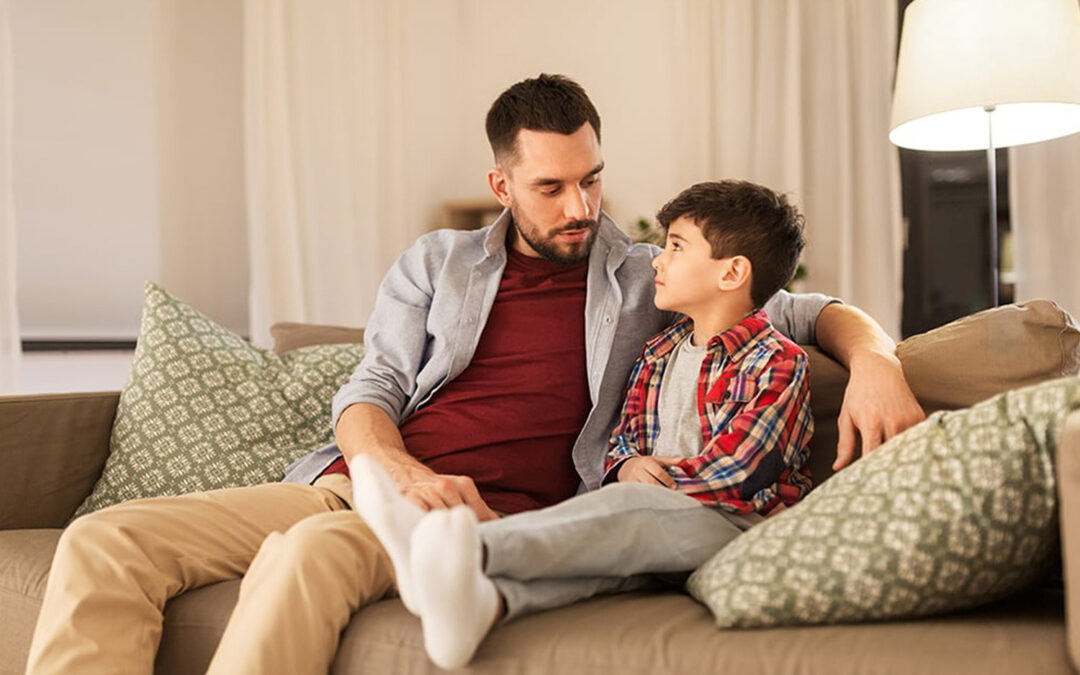
by North Shore Child & Family Guidance Center | Dec 3, 2023 | In The Media, Newsday
By Tiffany Cusaac-Smith, Published in Newsday, October 21, 2023
After giving birth to her son in March, Justine Hofsiss lay in the fetal position on a couch at her Franklin Square home unable to function.
Ringing in her ears, heart palpitations, sweating, shaking — those were among the symptoms she shared with her best friend, a nurse, who tried to provide remedies until realizing the salve might be mental health treatment.
“It was a very scary, very overwhelming time in my life, where I felt like I had no control of my body whatsoever,” said the mother of two who had already eschewed driving because of her emotions.
With a referral from the friend, Hofsiss in April turned to the North Shore Child & Family Guidance Center, crying in an intake call but finally hearing a voice to help make sense of her feelings after a traumatic birth and pregnancy.
“I hung up the phone and just cried because I’m like, ‘OK, this isn’t going to be forever. I’m going to be OK. I’m gonna get help,’” she said.
The North Shore Child & Family Guidance Center’s maternal health and wellness program is among a handful of places on Long Island working to treat pregnant people and those who have recently given birth for mental health issues such as anxiety or perinatal depression, which is common but can impact a woman’s ability to function — and even be life-threatening.
Roughly one in eight women in the United States said they experienced symptoms of postpartum depression since the birth of their babies, according to the Centers for Disease Control and Prevention.
Mental health conditions are the leading cause of pregnancy-related deaths, the CDC said, citing data from 2017 to 2019. That figure includes suicides and overdoses related to substance use.
In New York, mental health issues made up 15% of pregnancy-related deaths in 2018, or the third-leading cause, the state Department of Health said.
The overall number of women in the state who asked for help for depression after giving birth has steadily increased from 2017 to 2020, moving from 7.7% to 11.3%, the Department of Health said.
Meanwhile, the number of women who said a health care provider had asked them about depression symptoms at a postpartum visit moved from 76.1% in 2016 to 82.4% in 2020, the DOH said.
Childbearing is often perceived as a joyous moment, but it is also a moment of immense physical and emotional change that can leave people in anguish, experts say.
“The expectation is this should be such a wonderful point in your life,” said Dr. Sue Cohen, clinical psychologist and a clinical director at the center.
She later added: “Everyone, maybe their parents say to them, ‘Oh, you should feel so grateful you have a healthy child,’ but they’re not feeling it.”
Barriers to getting mental health care
And while in the throes of mental health ailments, many women also face barriers to getting care, including the stigma of such illness and long waits to see providers, said Dr. Brittain Mahaffey, a licensed clinical psychologist and director of the Dialectical Behavior Therapy at Stony Brook Medicine.
In addition, some psychiatrists will not prescribe medication to people who are pregnant or breastfeeding out of fear of harming the child. Other times, women will forgo their prescriptions while pregnant.
The North Shore Child & Family Guidance Center maternal program seeks to be a bridge for women seeking care, taking referrals from OB/GYNs, pediatricians and word-of-mouth.
They then do a screening call to ensure the women don’t need to be taken to a hospital. Within a week of that call, the parent is seen.
“We treat it like an emergency because these moms are at risk, and the babies could be at risk,” said Cohen, later noting: “We need to make sure everyone’s safe.”
Cohen said many of the program’s clients have had a traumatic birthing experience. A depressive or anxious history is sometimes the case.
The patients go into individual therapy or with a partner. A staff psychiatrist works to provide care for women who are pregnant or have just given birth. Parents can bring their children if they come in for visits, as evidenced by the toys and children’s artwork in the offices.
The sessions usually take place over a year but can last longer.
“Some women just need a little support to get through this period and you know, are grateful that they’ve gotten this, and they can go back to their level of functioning,” Cohen said.
Anxiety after difficult delivery
While pregnant with her son, Hofsiss was hospitalized multiple times because her blood pressure spiked. During delivery, the baby’s heart rate dipped, and she was given oxygen.
After the birth, she stayed in the hospital for a week — away from her daughter, 5, and unable to adjust to everyday life.
“I had a full-blown anxiety attack because I was afraid that my blood pressure was not going to get better. It was constantly going to be high. I was never going to go home. We have this new baby now, we need to get adjusted. And my anxiety just got bigger and bigger.”
She reached out to the North Shore Child & Family Guidance Center, where she was diagnosed with postpartum depression and anxiety.
There, she met a therapist who gave her strategies to promote her care and mindfulness. One of the tools that she holds close is the idea of kintsugi. The Japanese technique mends broken pieces of pottery but still shows the seams, demonstrating both beauty, imperfections and endurance.
“It’s a different version of what you were, but it’s going to be a better version. And it’s OK that it’s different than what you were used to,” said Hofsiss, who is also on medication.
Mahaffey said the stress that mothers experience before they become a parent is one of the most important predictors of depression and anxiety.
Young parents may have more stress because of financial difficulties and mothers who have had a traumatic pregnancy could be also more prone to anxiety.
“I want people to know that mental health problems don’t just magically start in the postpartum; it usually starts during pregnancy and then worsens into the postpartum,” she said.
Depression deepens during pregnancy
After struggling to get pregnant, Dhipinder Walia said she felt “embarrassed” when depression crept back up while she was pregnant.
“I always just sort of felt like something was wrong with me because it is something I was asking for. So why, why couldn’t I just figure it out?”
Walia, 35, of Lynbrook, eventually told her OB/GYN that she was depressed, only for her to be given providers who had a long waiting list.
Meanwhile, she said, her feelings of depression were stronger and deeper than when she was a teen and in her 20s.
“Whereas before I just felt like I was unable to, like, find joy in things and like, I just needed help and getting there,” she said. But this time, “it was like, physical and mental pain.”
She got mental health care only after her child was born, after she mentioned her feelings to the child’s pediatrician, who called a social worker and put her in contact with the program.
Once in therapy, Walia said she learned how not to lean into distorted thoughts or how to set herself up for a good cry when she was feeling weepy.
By 18 months into therapy, she had better structures in place, aiding her overall health and giving her a clearer sense of her purpose.
“My purpose is to, you know, be a good mom and to support folks who need support,” she said. “But, I also feel like I’ve gained a lot of confidence and … understanding — all these abilities that I didn’t ever think I could have.”

by North Shore Child & Family Guidance Center | Dec 1, 2023 | Anton Media, Blog, In The Media
By Kathy Rivera, Executive Director/CEO, North Shore Child & Family Guidance Center
Children are always listening, even to things they may not have the ability to fully comprehend. Whether it be from social media, school, or adults in their lives, it’s inevitable that kids are hearing about the many tragedies that are occurring throughout the world today. Though a parent’s first instinct may be to shield their child from the anxiety and fear that comes with the unknown, avoiding the topic could leave their child feeling lost and helpless.
Discussing challenging world events with your children is a delicate but necessary task. By fostering trust, maintaining composure, promoting open communication, addressing social media influence, and helping children cope with anxiety, you can guide them through the complexities of the world while providing them with a safe and supportive environment. These conversations should be ongoing and adapted to your child’s age and maturity level as they grow and develop.
A foundation of trust
Children need to know that they can rely on their parents through hard times. It’s important to have a strong foundation of trust before going into any difficult conversation with your child. So, what’s the best way to do this? Dr. Sue Cohen, Director of Early Childhood and Psychological Services at North Shore Child & Family Guidance Center, highlights the importance of actively listening to your children. By paying attention to what they say, encouraging family conversations, and demonstrating mutual respect, you can build a strong foundation of trust. This is vital in helping your children navigate complex issues and challenges in the world.
Remain calm
Before explaining the news to children, it’s essential for parents to come to terms with it themselves. Kids are adept at picking up on adult emotions, often feeling affected by the stress, anger, and anxiety of their caregivers, so remaining composed while approaching the topic is crucial for effective communication. “Children feed into their parents’ tone, so if they give the information in a calm manner, children will know that they’re safe,” says Dr. Cohen.
Open communication
Parents should strive to understand what their children already know to gauge their exposure to external information. Get a sense of their awareness and correct any misinformation they may have encountered. Allow them to ask questions without judgment and answer them in an age-appropriate manner. For younger kids, assure them that the scary events are happening far away and that they are safe. For older children, stress the importance of finding reliable information on current events and knowing when to look away from the news.
Addressing social media
With the rise of technology and social media, kids today have unfiltered access to events happening anywhere in the world. What once could only be viewed on the nightly news or in the morning paper is now at our children’s fingertips 24/7. It is important to explain to tweens and teenagers the realities of social media. Anyone can have a platform on sites like TikTok and Instagram, which means that not everything they see is backed up by facts. Media literacy is taught in some schools, but it’s important to continue those lessons at home. Discuss the importance of finding primary sources, understanding biases, and recognizing historical context.
Dealing with anxiety
Exposure to tragic events can significantly increase anxiety levels in children, impacting their daily routine, sleep schedules, and eating habits. Dr. Cohen emphasizes the importance of maintaining regular routines, as children thrive on consistency. Encourage children to express their feelings through creative outlets like artwork and music, or by seeking support from a youth group or volunteer service. Staying mentally and physically active can significantly impact how children cope with distressing news.
Remember that support is there for your families as we all navigate this difficult time. Contact the North Shore Child & Family Guidance Center at 516-626-1971 if you or a loved one are struggling.

by North Shore Child & Family Guidance Center | Nov 20, 2023 | Blog
The holiday season is rapidly approaching, bringing with it countless expectations of family connection, laughter, gratitude, and joy. When these idyllic visions fall short, mental health often worsens, leading many to turn to alcohol and substance use to cope. As we gather around the table to give thanks, it’s equally important to understand the link between Thanksgiving and alcohol abuse, and what we can do to prioritize well-being during the holidays.
Why do the holidays serve as triggers for alcohol and substance use?
According to NAMI, 64% of individuals living with a mental illness report that the holidays make their conditions worse, often due to the increased amount of stress the holiday season brings. People tend to feel more anxious during this time for a variety of reasons: the holiday blues and seasonal affective disorder; the pressure of gift giving and overspending; unhealthy family dynamics; and much more. Studies suggest that people experiencing high stress levels have a greater likelihood of using alcohol or substances to forget their worries. These factors, combined with the culture surrounding alcohol during the holiday season, leads to an increased risk in the urge to over consume or relapse.
Setting boundaries
Rates of binge drinking increase during every holiday, but Thanksgiving is known to be among the worst offenders. The day before Thanksgiving has even earned the nickname “Blackout Wednesday,” as it is one of the most popular days for bars in America, even rivaling St. Patrick’s Day. For those suffering with alcohol and substance use issues, Thanksgiving can prove to be a major trigger. Family members that don’t understand sobriety may encourage a drink with dinner, thinking that “just one won’t hurt.” For some, even being in the same room as alcohol can be enough to compromise progress.
In these situations, it is important to set boundaries and communicate with your family. Here are some ways you can express your intentions and stick to them at your holiday dinner.
● Host Thanksgiving yourself. Your house, your rules. By hosting, you can ensure alcohol will not be on the menu.
● Let people know ahead of time that you aren’t drinking. If you feel comfortable sharing your sobriety journey with select family members, explain how important it is that you aren’t offered alcohol.
● Be the designated driver. Giving yourself the responsibility of driving someone else home at night will further motivate you to refrain from drinking.
● Have a non-alcoholic drink in your hand at all times. Consider bringing an alcohol-free beer, wine, or juice to sip on throughout the night. Holding a beverage can deter people from offering you something alcoholic to drink, and will help lessen feelings of missing out.
● Stay busy. Offer to help with the cooking, cleaning, and serving throughout Thanksgiving dinner. This can help to keep your mind distracted and away from thoughts of alcohol and anxiety.
As the holidays draw near, it’s important to value the things we should be most grateful for: our well-being, and that of our loved ones. Understanding the triggers for overconsumption or relapse & knowing when and how to set boundaries are integral in maintaining a healthy lifestyle during the season of gratitude. If you or a loved one show signs of alcohol and substance use, call the Guidance Center at (516) 626-1971 or click here to get connected to our drug and alcohol treatment and prevention services. It is never too late to turn hurting into healing

by North Shore Child & Family Guidance Center | Sep 7, 2023 | Blog
By Guest Blogger Ronnie Salazar
Children’s mental wellness plays a pivotal role in their overall development and happiness. As young minds navigate the challenges of growing up, it is essential to prioritize their emotional and psychological well-being. A solid foundation of mental wellness not only fosters resilience but also contributes to better academic performance, healthier relationships, and a positive outlook on life.
In today’s digital age, children are exposed to various technological devices and platforms. However, these digital tools can also serve as a powerful medium for nurturing kids’ mental wellness. Digital creativity, encompassing various forms of artistic expression such as digital art, music, storytelling, and video editing, can provide a safe and constructive outlet for children to explore their emotions, build self-esteem, and cope with stress.
The Power of Digital Creativity for Kids
Expressive Outlets for Emotional Release
Digital creativity offers children a unique platform to express their thoughts, feelings, and emotions in a safe and non-judgmental environment. Kids can channel their innermost emotions, allowing them to process complex feelings and experiences. Whether they create digital paintings, compose music or edit videos, these outlets enable children to communicate and cope with emotions they might find challenging to express verbally.
Boosting Self-Esteem and Confidence
As kids witness the results of their creative efforts, whether it’s a captivating piece of digital art or a self-edited video, their sense of achievement grows, boosting their self-esteem and confidence. Positive feedback from peers, family, and teachers further reinforces their belief in their abilities, contributing to a solid and healthy self-image.
Stress-Relief and Relaxation through Creativity
When immersed in creative activities, the mind focuses on the task at hand, diverting attention from daily stressors. Whether it’s composing a soothing piece of music, engaging in digital storytelling, or experimenting with art, these creative pursuits can become a form of mindfulness, promoting a sense of calm and relaxation in young minds.
Exploring Digital Art and Video Editing
Digital Drawing and Painting for Self-Expression
Digital drawing and painting provide an exciting and accessible medium for kids to express themselves artistically. With a wide range of digital tools and software available, children can unleash their creativity through vibrant colors, imaginative compositions, and intricate details. This form of self-expression allows them to communicate their thoughts and emotions visually, enabling a deeper understanding of their inner world. Digital art also encourages experimentation and the freedom to undo and redo, empowering children to explore and refine their ideas without fear of mistakes.
Video Editing as a Creative Outlet
Video editing opens up a world of storytelling possibilities for kids. By piecing together clips, adding effects, and incorporating music, children can create their narratives, documentaries, or artistic pieces. Video editing allows them to explore their storytelling abilities and perspective, giving them a sense of authorship over their creations. Whether they capture real-life events or conjure up fantastical scenarios, video editing provides a means for kids to share their ideas and perspectives with others, fostering a sense of connection and communication through visual storytelling.
Music and Sound Creativity
Digital Music Tools for Kids
From user-friendly apps to virtual instruments, children can explore the world of music composition and production in exciting ways. These digital music tools often offer pre-made loops, easy-to-use interfaces, and interactive tutorials that allow kids to experiment with melodies, rhythms, and harmonies. Engaging with digital music tools empowers children to create their musical pieces, fostering a sense of accomplishment and creativity. You can try Virtual Drumming or Song Smith app.
Benefits of Music for Kids’ Emotional Wellbeing
Music holds a profound impact on children’s emotional well-being. Engaging in music and sound creativity can be a cathartic outlet for emotions, enabling kids to express themselves in ways they might not be able to with words alone. Whether playing an instrument, composing music, or using digital sound effects, children experience a range of emotions, from joy and excitement to introspection and comfort. Music has the power to evoke powerful emotions and memories, offering solace during challenging times and enhancing positive emotions during happier moments.
Interactive Storytelling and Writing
Digital Platforms for Storytelling
Interactive digital platforms now offer immersive and engaging storytelling experiences that go beyond traditional books. These platforms incorporate elements like animations, sound effects, and interactive choices, allowing children to actively participate in the narrative. Through e-books, interactive apps, and online storytelling communities, kids can explore a vast array of stories tailored to their interests, sparking their creativity and curiosity.
Fostering Imagination and Empathy through Stories
As they embark on virtual adventures and make decisions that shape the storyline, children are encouraged to think critically, solve problems, and envision new possibilities. Moreover, exposure to diverse characters and perspectives in stories helps kids develop empathy and understanding of others’ experiences. By immersing themselves in these interactive narratives, children can develop emotional intelligence, empathy, and a profound appreciation for the power of storytelling in connecting hearts and minds.
Overcoming Challenges and Concerns
Addressing Cyberbullying and Online Safety
Parents and educators should educate kids about the importance of responsible online behavior and how to recognize and report cyberbullying incidents. Creating an open and supportive environment where children feel comfortable sharing their online experiences can help identify and address any issues promptly. Implementing parental controls and monitoring tools can also provide an added layer of protection, ensuring kids’ safety while exploring the digital world.
Balancing Screen Time with Offline Activities
While digital creativity offers numerous benefits, excessive screen time can lead to various challenges, such as sleep disturbances and reduced physical activity. Encouraging kids to participate in offline activities, such as sports, reading, or spending time with family and friends, helps foster a well-rounded lifestyle. Setting clear boundaries and designating tech-free periods can promote healthier screen habits and ensure that digital creativity complements, rather than substitutes, other valuable aspects of their lives.
Conclusion
Digital creativity offers children a myriad of benefits, from providing expressive outlets for emotional release through digital art and video editing to fostering self-esteem and confidence. Engaging in music and sound creativity allows children to connect with their emotions and experience the therapeutic effects of creative expression. While navigating the digital landscape, addressing concerns like cyberbullying and balancing screen time is crucial for ensuring a safe and well-rounded experience.

by North Shore Child & Family Guidance Center | Aug 10, 2023 | Blog
By Guest Blogger Chloe Cohen
As the need for mental health services for youth becomes increasingly necessary, with 21.8% of children diagnosed with one or more of the common mental health conditions, it’s vital to highlight the voices of those being affected: the children. Recent studies and institutionalized changes surrounding the mental wellbeing of children can be largely attributed to the speaking out of young people and normalization of seeking help.
It can be questioned why diagnosis statistics are at a steady incline. It remains true that it may be virtually impossible to pinpoint the exact causal pathway to one rooted issue as mental disorders are largely multifactorial. Despite this, it is important to listen to the children impacted in order to make advancements in our systems and resources.
Combating the Stigma: How Generation Z Views Mental Health
In a study focused on the generational differences in mental health, Deloitte found that in terms of holistic health priorities, the leading concern for Generation Z is mental health with physical health following in second. This is a drastic difference to the older generations who majorly don’t consider mental illness to be a “health” problem – Mental Health America found that only 38% of adults 65 and older believe depression to be a health issue. The stigma surrounding mental health has been a prominent setback towards advancements in treatment for years. Generation Z, myself included in this demographic, has taken this matter into our own hands in consistently spreading awareness and further, advocating for the need for accessible treatment and resources.
Despite more frequent mental health conversations, the gap between prevalence and treatment is still vast so it’s crucial to listen to the youth’s recommendations on what they believe will combat these struggles.
So, What Should Be Done?
New York State has taken notice of the youth’s call to action and began to dig deeper at what can be done for these issues. Governor Hochul invested a striking $1 billion in youth mental health studies to address the CDC instated mental health crisis among youth. The premise of the study was to collect feedback from children all over NYS with a focus on what types of programs and advice youth could envision de-escalating the crisis.
According to the June 2023 published Youth Mental Health Listening Tour Report, here are some key youth recommendations from the study:
● Involving young people in decision making/ mental health program design
● Hiring diverse health professionals that can relate to a variety of students
● Increase amount of youth led programs
● Educate adults on how to support young people, listen without judgment, and establish clear lines of confidentiality
● Invest in social and recreational activities to promote mental wellness
It’s the duty of the professionals and NYS to hear these results and put them into action. Now, where does The Guidance Center fall into this?
The Guidance Center is Here to Help
North Shore Child & Family Guidance Center emphasizes compassion and innovative treatments for children from birth to 24 years old. Our staff across all three locations contains a wide range of diverse individuals with an array of experiences in order to optimize the relatability and relationships between therapist and client, as is an important factor in mental health care according to the report. Additionally, The Guidance Center provides a number of programs and services to support the youth in the way that they need to be supported. Each client is comprehensively evaluated, tailored to an individual treatment plan that may include any combination of individual, family, and group therapy, and if needed, medication management.
As an intern in The Guidance Center, I have had the privilege of learning about our programs and closely working with the staff that make it all happen. I can say with confidence that The Guidance Center not only provides services that accommodate these youth recommendations, but the staff as a whole is truly dedicated to ensuring the mental wellbeing of our youth. Outside of therapy, The Guidance Center offers programs such as the Wilderness Respite Program that hosts children from any mental health facility to come together and participate in adventurous activities as a gateway to mastery of social skills and youth empowerment. The Guidance Center also offers programs such as the LGBTQ+ & Latina Girls Project that bring together clients who may be in need of extra support from those who have similar experiences.
Our staff is specially trained for working with children and their families with no limits or restrictions to provide our clients with the care they need. A major setback to children receiving services is financial limitations. At The Guidance Center, we are dedicated to reaching everybody who needs us. As said by Executive Director/CEO, Kathy Rivera, “We turn no one away for any inability to pay… We are committed to equity in mental health regardless of what your ZIP code is, what your bank account looks like. Everyone deserves to have access to care.” The Guidance Center is a place where youth heal and thrive accessibly and affordably as we stay up to date with changing times and individually molded treatment plans.
If you or your child is in need of support, know that we are here to help! Call us at (516) 626-1971 to learn more about our services or make an appointment today.





